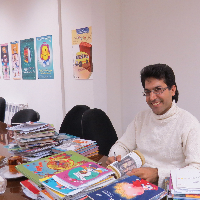Creative Optical Metamorphosis in Children’s Picture Books: Based on SCAMPER’s Idea Generation Model
The SCAMPER model or "idea-provoking questions" was presented by A. F. Osborn for ways of forming critical thinking. SCAMPER is an abbreviation of seven creative idea generation methods which are adopted from the first letters of the words "Substitute", "Combine", "Adapt", "Modify", "Put to another use", "Eliminate" and "Reverse".In the method of substitute, the idea maker tries to get new ideas by asking questions such as what can be replaced and what part can be replaced.Based on the method of combination, the idea maker achieves a new thing by combining two products, two functions or two previously unrelated goals.The method of adaptation seeks to adapt and adapt similar cases that have existed in other fields, and typical questions of this method are "What can we make this look like?"According to the method of modification, the idea maker seeks something better by enhancing, multiplying, increasing the quantity or quality of the product, or ancillary services. A typical question of this method is "by strengthening or multiplying which part of the product can reach the optimal limit?""Put to another use" is one of the basic and important methods in creativity and idea generation, and it is always in search of other and new applications for existing products and services.The Eliminate method seeks to simplify the product, and sample questions include: What can be eliminated? What if it gets smaller?In the reverse method, the change of sequence and direction is taken into consideration, and a typical question in this method is: "What happens if the mentioned sequential relationship changes direction?"Image transformation has been welcomed by children's audiences due to its playful nature, and because of its background in the works of painters such as G. Arcimboldo, it is always one of the most used techniques in the art of illustrating children's books. But Iranian researchers have not paid much attention to this popular art technique. Parts of the joint article of Noroozitalab and Rostami (2013) have paid attention to the relationship between optical metamorphosis and optical illusion. In the mentioned article, the works of Magritte, Escher, Gonzalvez, Octavio Ocampo and Jos De Mey have been analyzed with re-spect to form, content, composition, color, light, style, structure, lines, etc. In his article (2022), Zanjanbar mentioned optical transformation in children's picture books and introduced it as a special state of "personification". In another article, Zanjanbar (2023 B) paid attention to image metamorphoses in four picture books Are you a stork or a woodpecker? (Khodaei, 2012), I stand on my hand (Khodaei, 2020), Elephant Buttons (Ueno, 1973) and "I see, I see" (Henderson, 2019) from the perspective of deconstruction. have given.On the one hand, pictures are one of the most important sources of modeling thinking for pre-operational children, and on the other hand, image transformation strengthens children's ability to see things in a different way and to have a fluid and flexible look. In addition, since optical metamorphosis is essentially a combination of game and image; Its importance has always been understood experimentally for illustrators of children's books. Meanwhile, its importance has been neglected in academic research in Iran. This research focuses on the two issues of image creativity and optical transformation for the first time in children's literature.The purpose of this article is to show that the idea of image transformation follows the idea generation model of Scamper. In this regard, this article answers two questions: 1. How does the Scamper model create a creative optical transformation in children's book illustrations? 2. By dividing each of Scamper's seven methods into smaller subcategories, how can the structure of image transformations be morphologically analyzed?The statistical population of this article is children's books based on image transformation. The size of the studied sample is one hundred and ten picture book titles of age group "A", "B" and "C", of which forty one titles will be mentioned below. Most of these picture books are authored. Picture books mean books in which the picture does not have a decorative aspect; Rather, it is considered the main part of the discourse of the story. The method of the present research is inductive and analytical-descriptive. The data collection method is a library and a purposeful sampling method (suitable to the Scamper components).This research has shown that image transformations are the result of using one or more scamper methods simultaneously. In some examples, although several Scamper ideation techniques have been used at the same time; But the role of one of Scamper's tricks has always been more important in creating a optical transformation, and the rest have played the role of facilitator and foundation for its realization. For example, if the optical transformation is the result of turning the book (reverse technique); In the eyes of the reader who, with his active participation, keeps turning the book upside down to find out the ambiguity and multifacetedness of the image; The reverse trick is more prominent than tricks like Combine. This article has divided each Scamper trick into new subcategories.
- حق عضویت دریافتی صرف حمایت از نشریات عضو و نگهداری، تکمیل و توسعه مگیران میشود.
- پرداخت حق اشتراک و دانلود مقالات اجازه بازنشر آن در سایر رسانههای چاپی و دیجیتال را به کاربر نمیدهد.



